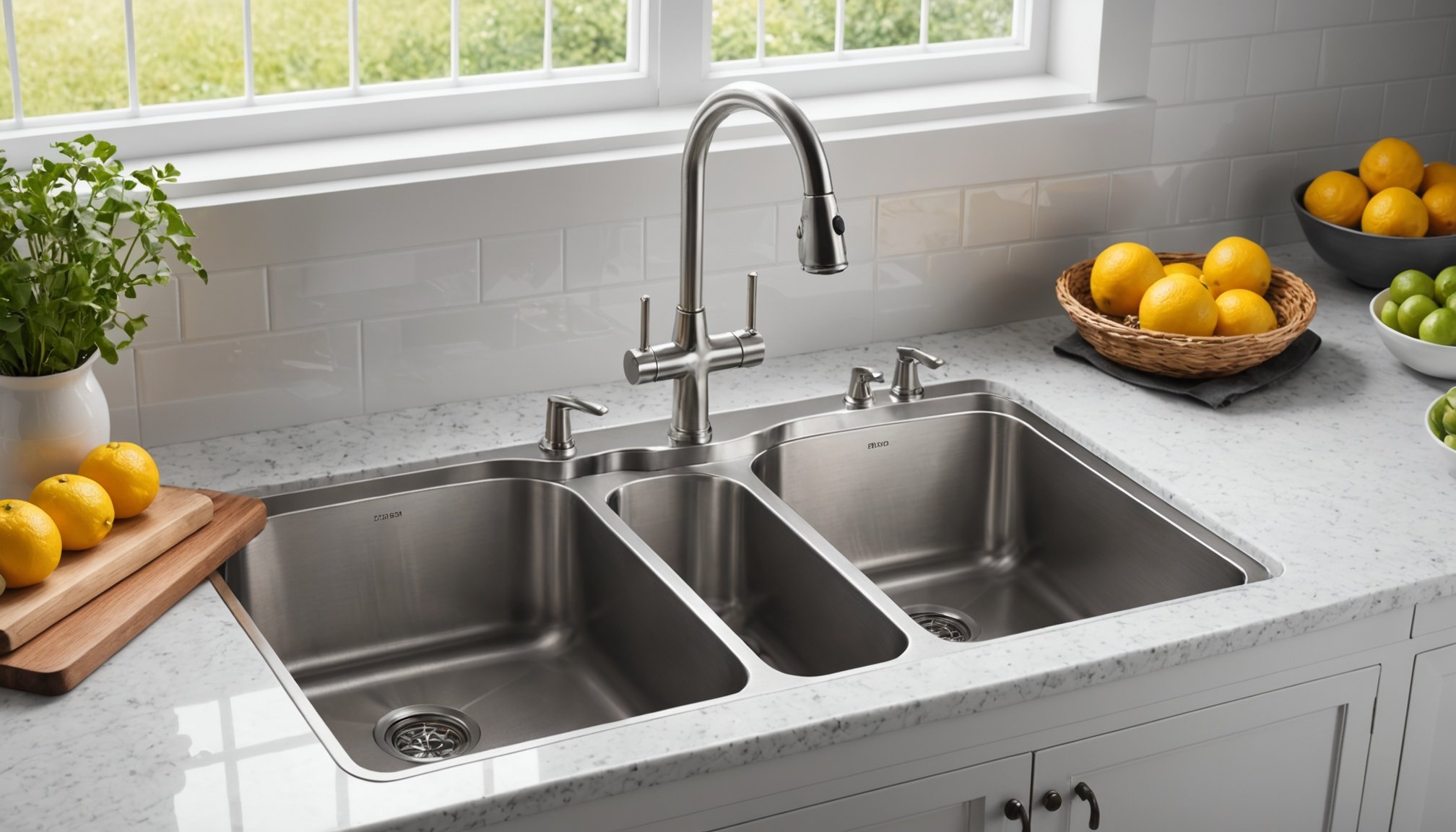Understanding Kitchen Sink Sizes
When considering kitchen sink dimensions, it’s important to acknowledge the plethora of options available. A standard kitchen sink typically measures between 24 to 36 inches in length, with a width of about 20 inches. Depth also varies, often ranging from 8 to 10 inches. These measurements can serve as a basic sink size guide, but individual needs might necessitate deviations.
Your family kitchen needs play a pivotal role in selecting the right sink size. For larger families, a double-bowl sink might better accommodate more extensive washing and food preparation tasks. On the other hand, smaller households may find that a compact single-bowl sink is both space-efficient and adequate for daily use.
Topic to read : Transforming kitchen safety: discover creative iot solutions for a secure culinary journey
Sink size is not only about numbers but also how it fits within your kitchen layout. A large sink in a small kitchen might dominate the countertop space, leaving less room for other kitchen duties. Conversely, a small sink might be less functional in a spacious kitchen, missing out on potential utility.
Finally, assess your cooking habits. If you’re an avid cook, a larger sink can help manage cookware and ingredients effectively. Balancing these factors ensures your sink size complements your lifestyle and kitchen dynamics.
Also to read : Elevate your culinary space: achieving perfect balance between natural and artificial lighting
Factors to Consider in Selecting Sink Size
When choosing the perfect sink size, several factors come into play, primarily rooted in family cooking habits, kitchen layout, and functionality.
Cooking Frequency and Meal Prep
Understanding your cooking frequency is vital. For families who prepare large meals daily, a larger sink might be necessary to accommodate pots and pans comfortably. In contrast, those who cook occasionally might find a smaller sink sufficient. If frequent large family gatherings are a norm, opting for a more spacious sink configuration could enhance kitchen efficiency. Imagine having a double-basin sink that allows easy meal prep and cleaning simultaneously.
Kitchen Space and Layout
Evaluating your kitchen space is crucial. A spacious kitchen can accommodate an expansive sink, enhancing workflow and providing ample room for culinary creativity. Conversely, a compact kitchen might benefit from a streamlined, single-basin sink that maximizes space without sacrificing practicality. Ergonomics play a role here, ensuring the sink’s placement supports a seamless cooking experience.
Family Size and Daily Use
The family size directly impacts the required sink capacity. Larger families generally need larger sinks to handle bulkier dish loads. Understanding your daily usage patterns can guide you in selecting the right sink size, balancing capacity and convenience. For small households, a modest sink can serve adequately, while larger families may find value in a more generous arrangement.
Sink Bowl Configurations
The kitchen sink is a quintessential feature of any kitchen, and selecting the appropriate bowl configuration can vastly enhance functionality. Understanding the difference between a single bowl sink and a double bowl sink is crucial for making the right choice.
A single bowl sink offers a minimalist design, providing a spacious area ideal for washing large pots and pans. This configuration shines in kitchens with limited space or for homeowners who frequently handle oversized cookware.
Conversely, a double bowl sink is quintessential for multitaskers. It features two separate basins, making it invaluable for juggling multiple kitchen tasks. One side can be reserved for dirty dishes, while the other is designated for food preparation or rinsing.
Bowl sizes within these configurations also matter significantly. Larger bowls accommodate substantial washing tasks, while smaller ones are perfect for light rinsing and supplies soaking. For larger families or those who entertain often, a double bowl sink may prove more efficient, permitting simultaneous tasks. Conversely, a single bowl sink is better suited for smaller households or those prioritising a sleek look with maximum workspace.
Ultimately, balancing your household’s specific requirements and daily kitchen activities will guide you toward the optimal sink configuration.
Material Choices for Kitchen Sinks
When selecting kitchen sink materials, it’s essential to consider durability and maintenance to ensure long-lasting use. A popular option is stainless steel, renowned for its resilience and low maintenance. It’s less prone to chipping or breaking, making it ideal for busy families who need a robust solution. Stainless steel sinks offer a sleek, modern aesthetic and are easy to match with various kitchen styles. However, they might show water spots or scratches over time.
Composite sinks, usually made from materials like granite or quartz, provide a contemporary look and come in diverse colours. These sinks are known for their superior durability and scratch resistance. They might require a bit more cleaning effort to avoid staining but their resilience to heat and impacts is remarkable.
Cast iron sinks, coated with enamel, impart a classic and elegant appeal, often preferred in traditional kitchen designs. Though highly durable, they can be prone to chipping and require careful maintenance to retain their glossy finish.
- Stainless steel: Durable, low maintenance, modern look, may show scratches.
- Composite: Scratch-resistant, various colours, contemporary, potential staining.
- Cast iron: Classic style, requires careful maintenance.
Choosing the right material involves balancing aesthetics, durability, and the required level of care to align with your lifestyle and kitchen design preferences.
Popular Sink Sizes and Recommendations
Choosing the right sink size is crucial in designing a functional kitchen, especially for families. As lifestyles evolve, so do the demands for popular sink sizes in family kitchens. Among the trending options, large double-bowl sinks remain favoured for their versatility, allowing simultaneous washing and rinsing.
For families with young children, integrated drainboards can prove highly beneficial, providing extra space for drying delicate items. Families who frequently host gatherings might benefit from oversized single-bowl sinks that accommodate larger cookware effortlessly.
Conversely, compact kitchens in smaller households may necessitate space-saving options. Here, undermount or small single-bowl models can be ideal, optimising countertop space without sacrificing functionality.
For visual learners, understanding what size works best involves comparison. Families with four or more may find a 36-inch sink most accommodating, providing enough room for diverse tasks without overcrowding. Smaller families or couples could efficiently use a 24-inch sink, balancing space and utility perfectly.
No matter the structure of your home, selecting a sink suited to your unique needs enhances kitchen interaction. Each type offers distinct advantages, ensuring you can tailor your choice to meet daily requirements effectively.











